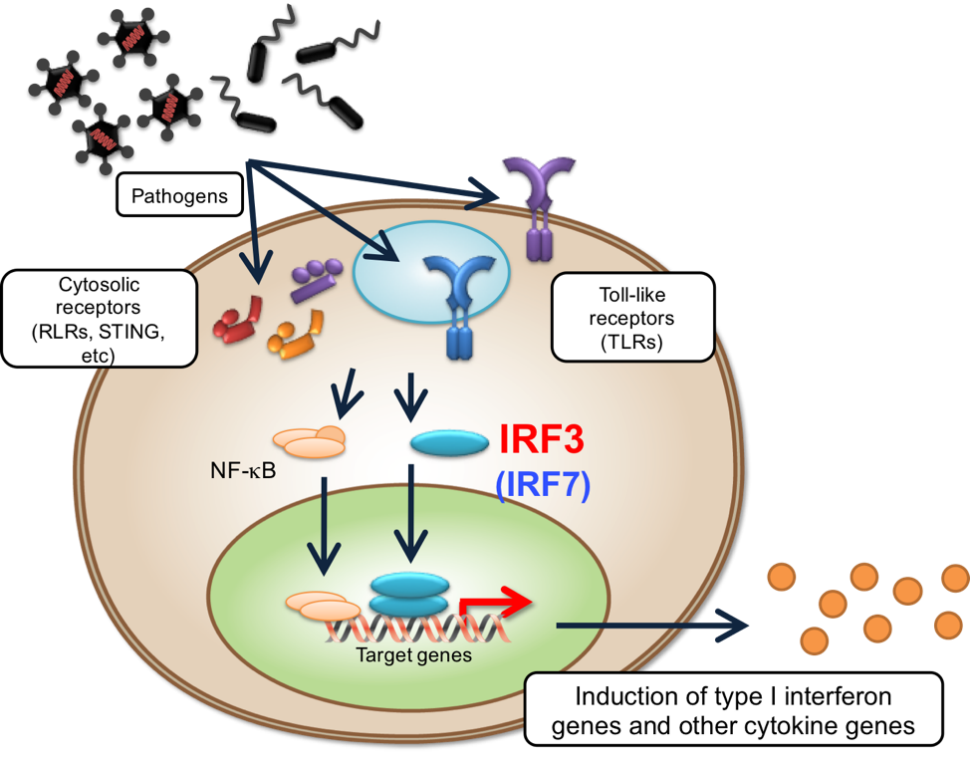 |
November 2020 Mouse of the Month |
|
A key transcription factor for innate immunity: IRF3
B6.Cg-Irf3<tm2.2Ttg> (RBRC10094)
|
|
IRF3 (IFN regulatory factor 3) is one of well-known transcription factors which is essential for innate immune responses in various kinds of cells. In uninfected cells, IRF3 exists in cytoplasm as an inactive form. Once virus or microbe infection occurs, pattern recognition receptors are stimulated and IRF3 translocates into nucleus as a phosphorylated active form. Finally, IRF3 promotes the transcription of some cytokine genes such as type I IFN genes. IRF3 has multi-functions including not only the host defense from pathogen infection but also the development of proinflammatory diseases, autoimmune diseases, lipopolysaccharide-induced endotoxin shock, etc. In conditional Irf3 knockout mice (RBRC10095), exons 2-4 of the Irf3 gene (containing start codon sequences) are flanked by loxP sites [1]. By mating experiments with systemic Cre driver mice, depositors (Dr. Tadatsugu Taniguchi and Dr. Hideyuki Yanai) and their colleague established Irf3 null deficient mice (RBRC10094) and clarified that IRF3 ablation occurred at the genome and protein level. Moreover, they analyzed IRF3 functions for T-cells, B-cells or myeloid cells by crossing Irf3 floxed mice with each suitable Cre driver strains. Noteworthy, conventional Irf3 knockout mice (RBRC00858: B6;129S6-Bcl2l12/Irf3 <tm1Ttg >/TtgRbrc) were shown to carry the null mutation for the Bcl2l12 gene flanking Irf3 gene [2]. Novel Irf3 null deficient mice (RBRC10094) retain the intact Bcl2l12 gene. Understanding of innate immune mechanisms is expected to lead the opportunity to elucidate the pathogenesis and exploit a new therapeutic target for infectious diseases. Therefore, Irf3 floxed strain which is enable to study the cell-and tissue-specific IRF3 functions is useful strain for further study. |
| Depositor | : | Tadatsugu Taniguchi, Ph.D. & Hideyuki Yanai, Ph.D. University of Tokyo |
|
| Strain name | : | B6.Cg-Irf3<tm2.2Ttg> (Irf3 gene-deficient mice) |
|
| RBRC No. | : | RBRC10094 | |
| Strain name | : | B6.Cg-Irf3<tm2.1Ttg> (Irf3 gene-floxed mice) |
|
| RBRC No. | : | RBRC10095 | |
| References | : | [1] | Yanai H, Chiba S, Hangai S, Kometani K, Inoue A, Kimura Y, Abe T, Kiyonari H, Nishio J, Taguchi-Atarashi N, Mizushima Y, Negishi H, Grosschedl R, Taniguchi T. Revisiting the role of IRF3 in inflammation and immunity by conditional and specifically targeted gene ablation in mice. Proc Natl Acad Sci U S A. 2018 May 15;115(20):5253-5258. |
| [2] | Nakajima A, Nishimura K, Nakaima Y, Oh T, Noguchi S, Taniguchi T, Tamura T. Cell type-dependent proapoptotic role of Bcl2L12 revealed by a mutation concomitant with the disruption of the juxtaposed Irf3 gene. Proc Natl Acad Sci U S A. 2009 Jul 28;106(30):12448-52. |
||
| November 2020 Saori Mizuno, Ph.D. Contact: Experimental Animal Division, RIKEN BioResource Research Center (animal.brc@riken.jp) All materials contained on this site may not be reproduced, distributed, displayed, published or broadcast without the prior permission of the owner of that content. |





